 Two and a half weeks ago, I posted a report on the initial results of a free copy promotion I ran, using four of the more effective book newsletter services. That campaign was successful in the near term, resulting in 4,360 downloads of my second book. In the conclusions, I noted:
Two and a half weeks ago, I posted a report on the initial results of a free copy promotion I ran, using four of the more effective book newsletter services. That campaign was successful in the near term, resulting in 4,360 downloads of my second book. In the conclusions, I noted:
I’ll need to collect further data before I can report back on whether a trial of this scale, duration and impact had the desired effect. The real test will be whether a week from now my base line of sales and page reads steps up from the base line before the sale.
And the answer is?… [drum roll]…No on sales, yes on reads. For the details, read on. As before, I’ll include specific figures and detailed sales charts.
Goals and Data
First, let’s do a brief review of what this exercise is all about.
For some years now, I’ve been investigating and reporting on the various promotional avenues available to authors. Almost all of them are time-consuming; some of them can be very expensive; and very few of them work – sometimes at all. One of the most hallowed of these methods is the free giveaway. So well enshrined is the freebie that the ability to run free sale days is considered to be one of the prime benefits of enrolling your book exclusively in the Kindle Select program.
And at one time it appears that free sale days were highly effective. But are they still useful today? Determining the results is what these two essays are about (you can read how and where the promotions ran, and what they cost, here).
An important aspect of any promotion is being clear on your goals. Another is being sure that you can measure your success to determine whether the effort is worth repeating. For a free promotion, an author may want to achieve one, or more likely all, of the following:
- Achieve more visibility and buzz for the promoted book
- Get a large number of people to read the book
- Get more reviews for the book, especially at Amazon
- Boost the sales momentum for the book
- Sell additional books, often in the same series, to the readers that download a free copy
The types of data you would use to measure success are rather obvious, although an author’s real-time access to the information needed may be limited, depending on how her book is distributed:
- Daily sales, and the sales trend, of the promoted book following the sale
- Daily sales of other books by the author, especially if they have been promoted in the back matter of the promoted book
- Kindle page reads, if the book is enrolled in the Kindle Library and/or Amazon Prime programs
- New reviews of the promoted book
If your books are enrolled only in Amazon Select, then your monitoring will be quite simple. The best measure will be your Kindle Author Dashboard report, which provides charts and figures for the number of copies you’ve sold and the number of pages that have been read. Strangely, the Kindle dashboard updates much more quickly and more often than your books’ Amazon ranks are calculated and posted (the lag seems to be at least six hours). That said, it still takes some hours between the time that a copy of your book is sold or a page is read before the results show up in your dashboard
If your books are in other distribution channels as well, then you will only be able to assemble your comprehensive results as they become available, either site by site, if you have uploaded them yourself (e.g., at Apple iTunes, Google Play, Barnes & Noble, Kobo and so on) or in a single dashboard, if you’ve used a distributor, like SmashWords or Draft2Digital. The speed at which sales figures make their way to these distributors will vary, as will their own times and frequency of updating your account.
Either way, Amazon will likely be your best tool for measuring your success, since the significant or great majority of your sales will usually be through Amazon. Since what you’re looking for is magnitude of response rather than exact figures, this will be more than sufficient.
Results
So with that by way of prelude, two and a half weeks later, what were the results of those 4,360 downloads, as measured by the success criteria listed above? Let’s take a look at sales first, using my Kindle Dashboard charts.
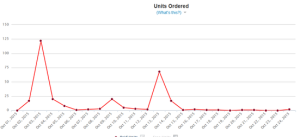 Before we get too excited about the big spike on the left (peaking at 122 sales the day after the free promotion ended), it should be kept in mind that many people probably didn’t get around to reading their book promotion email newletters until the next day, by which time I had raised the price to (only) $0.99.
Before we get too excited about the big spike on the left (peaking at 122 sales the day after the free promotion ended), it should be kept in mind that many people probably didn’t get around to reading their book promotion email newletters until the next day, by which time I had raised the price to (only) $0.99.
Since all of the promotion emails included discount as well as free books, there would have been little disincentive to buy the book after it went from free to $0.99. So we can’t count those sales as being a follow-on effect of the promotion – they were a direct result of the promotion itself. It’s possible that some of the sales might be a result of the time my book spent in the #1 spot on the political and thriller lists, and half way up in the Amazon All Free Kindle Books list.
Unfortunately, we also can’t credit those spikes to the right to the free promotion, either, since they occurred on the days that I ran discount sale promotions (I’ll report on them in a future post).
Now let’s take a look at Kindle Page reads, which presents a different, but equally important, set of data.
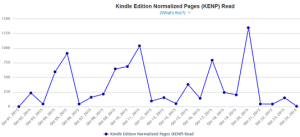 The first thing I learned from this chart is that people read a whole lot more on weekends than they do on weekdays. I’d like to think that it might also mean that some people read my book straight through, but unfortunately, there’s no way to tell whether your book riveted a few people, or disappointed a much larger number.
The first thing I learned from this chart is that people read a whole lot more on weekends than they do on weekdays. I’d like to think that it might also mean that some people read my book straight through, but unfortunately, there’s no way to tell whether your book riveted a few people, or disappointed a much larger number.
Either way, one take away from this chart is that running a sale (or a discount) on Wednesday – Friday, rather than during the weekend itself, is a good idea. That way your book will be top of the mind when the opportunity to settle in with a good read arises. Another reason is that I was informed by one of the best services that downloads are lower on Saturdays and Sundays, presumably because people are otherwise occupied and less likely to be on-line.
While the chart looks impressive, it’s less so if you can see the numbers. Added together, they show about 8,000 page reads since the sale. Since the book is 330 pages long, that means that only the equivalent of 24 books have been read cover to cover. How good or bad a percentage of all downloads that might be is impossible to tell, since Amazon doesn’t report how many downloads enter these programs – only how many pages are read after they do.
To put the results of the free give away in perspective, here’s another page reads chart, this time showing page reads over the lasts 90 days:
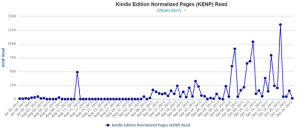 Clearly, the free promotion increased reads. But whether those reads will continue to build, or start to fall off remains to be seen. If they continue to rise, I expect it will be increasingly likely that they will be the result of word getting around that the promoted book is a good read rather than that Kindle owners are stumbling on an old free download.
Clearly, the free promotion increased reads. But whether those reads will continue to build, or start to fall off remains to be seen. If they continue to rise, I expect it will be increasingly likely that they will be the result of word getting around that the promoted book is a good read rather than that Kindle owners are stumbling on an old free download.
The last relevant chart relates to sales of my original book, The Alexandria Project, the first three chapters of which appear at the end of the free download. Did they enjoy a boost? Let’s see.
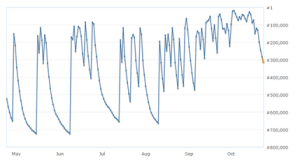 This time, the chart shows the Amazon Sales rank for the book, rather than the actual sales, because I’m in the process of getting the files back from the original service and publishing them myself. But that’s okay, because we’re measuring impact here, not exact sales.
This time, the chart shows the Amazon Sales rank for the book, rather than the actual sales, because I’m in the process of getting the files back from the original service and publishing them myself. But that’s okay, because we’re measuring impact here, not exact sales.
The first thing to note is that despite the fact that I spent no time promoting the first book after the second came out, the sales of the first book started to ramp up about a month after the second was released, illustrating the often-observed lesson that the best way to promote one book is to publish another one.
The second thing to note is that my first book enjoyed about two and a half weeks at its highest sales rate ever before beginning to fall off again. These sales appear to be a direct result of the exposure the book enjoyed indirectly from the free promotions.
Now that we’ve taken a look at all of the available data to date, what can we conclude about the value of the free promotion, as measured against the goals we listed at the beginning of this report? Let’s see.
Goal one: Achieve more visibility and buzz for the promoted book
Result: Minimal, to the extent the results can be measured
Goal two: Getting a large number of people to read the book
Result: The most likely answer is that, so far, at least, the number of people reading the book is modest. The number of Kindle pages read indicates that there has certainly some positive result, but without knowing how many of the books were downloaded by readers in the necessary Amazon programs it’s not possible to tell whether the data indicates a good result (few of those who downloaded the book were enrolled) or a bad one (many were)
Goal three: Getting more reviews for the book, especially at Amazon
Result: None to date
Goal four: Boosting the sales momentum for the book
Result: Average sales soon dropped to 0 – 2 a day; about a one book a day positive difference from the rate before the promotion
Goal five: Selling additional books, often in the same series, to the readers that downloaded a free copy
Result: There has been a meaningful, although temporary, improvement in sales of my first book
Conclusions and Lessons Learned
While it’s possible that there may be ongoing benefits from having those extra 4,360 books somewhere out there on peoples’ Kindles, phones and iPads, it’s clear that the near term benefits of the promotion have been very modest at best. It also needs to be kept in mind that I’ve run several less extensive discount promotions since the free campaign, so some portion of the results summarized above are certainly attributable to those efforts instead.
Obviously, an experiment with a sample set of one is anecdotal at best. However, the results observed are consistent with what I hear from other authors. Assuming that my data are representative, what should authors conclude? Here are my suggested takeaways:
- Whether or not to enroll in the Kindle Select program should be based on multiple factors rather than the ability to schedule free sale days easily
- Placing heavy reliance on free promotions would be imprudent. However, including free promotions in an ongoing promotional program is warranted, provided that your expectations are modest
- If your expense budget is limited, you will be very unlikely to recover your promotional costs if you use the services that are able to guarantee you thousands of downloads
Sadly, it seems as if there are very few silver promotional bullets available to authors. Another blank, incidentally, is blogging about writing to promote a book. Over 1,000 people read Part I of this series here and at my other blog in the first three days after I posted it. During the same period, I sold a total of 6 books, which is only the average current sale rate.
If you enjoy a good thriller and have found this and the prior installment valuable, you might consider trying one of my books, or sending one to a friend. You can find them here. I’ve temporarily lowered the price of The Lafayette Campaign to just $0.99.
Coming soon: A detailed review of costs and results of discount promotional services.

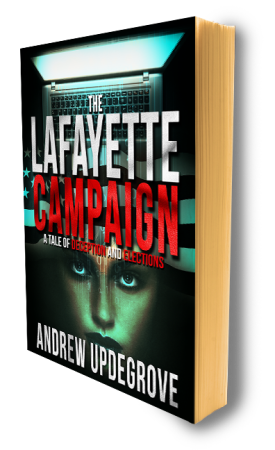
Thanks, Andy. Reporting your promotional results was probably a chunk of work also. Even though it wasn’t what you would’ve liked, it definitely gives me info regarding any similar efforts. And being so time strapped, it gives me a good excuse to just keep writing and getting/keeping myself healthy. Thanks so much!
And thank you, Adan. The results weren’t a surprise – they were pretty much what I expected. But as I’ve written often before, there’s a wealth of useless recommendations and a dearth of data in self-publishing. If we had more of the latter, we’d all be a lot better off.
Thank you Andy. just about to run a promo with a free so will let you know how it goes.
That would be great, Lucinda. I’ll look forward to hearing how it goes (and good luck).
Reblogged this on Maxpower's Blog and commented:
Intelligent inciteful and considered.. Great blog Andy..
Re blogged Andy great work indeed. Unfortunately free is not the way to go on my opinion at least .. This is FB excellent blog piece
Thanks very much – I appreciate the comments and reblogging. Of course, I would have been much happier to have been proven flat wrong and sold a ton of books.
Reblogged this on Eric Lahti and commented:
Excellent write-up on free book promotions. When I first published Henchmen I was loath to give it away, but giving it away was the best way to get it read.
Eric, what kind of results did you get, to the extent you could tell? And if you’ve done free promotions since, have they worked as well? I’m curious to see how our experiences compare.
I didn’t write it all down, but I’ve done free promos alone and seen a couple hundred books go out over a couple days. I’ve also done free promos backed up with ENRT and seen around 1300 or so over a couple days, and a promo with Fussy Librarian but no price drop yielded about twenty or so sales. Afterward there’s a bit of a boost, maybe a few extra here and there.
What a lot of work you’ve done on this – thanks for sharing your findings. Though by no means as analytical as your discoveries, I would say that I haven’t noticed any difference in my modest sales after a free promotion. I just hope that some of the downloads will eventually be read.
Thanks for sharing, Julia. Lack of information always makes me feel like we’re all just a bunch of lemmings, so the more we can figure out how the marketplace really works, the less time and effort we can all spend jumping off cliffs.
Thanks, Eric. It sounds like our experiences were pretty similar. I’ll go ahead and use up my remaining free days before my second Kindle Select period runs out, but going forward I don’t intend to re-up there, and plan to only do discount sales going forward. I’m betting that the net long term effect will be more more positive on an ongoing basis, plus my books will be on more platforms and I’ll recover some of the costs of the promotions. My experience so far is that this is the better way to go.
Very useful, or so my confirmation bias would have me believe! And I just bought your first book. Not charity or even gratitude on my part–it looks interesting. I spent a lot of years doing software/security stuff, and used to live near DC, so it’s a pretty good fit in principle at least.
Thanks, and I hope to go on to become a fan. {8′>
Thanks, David – I’m glad you found this useful. And thanks especially for giving my first book a try. I hope you do indeed become a fan.
Excellent post and very helpful. It’s great you shared your insights with us. I am, for now, sticking with Amazon. It’s all I’ve known really. I swore I wouldn’t give my book away again…..but reading your post I am considering running a promo again, I don’t think I would consider a freebie. All the books just lie out there on kindled and I don’t think the book would ever see the light of day again.
You have worked hard Andrew, once again thanks for passing on your findings.
Thanks very much, Sharon – that’s kind of you. I would certainly try promos again, particularly on EReader News Today, which looks like it provides the best value of all. As for staying only on Amazon, it’s not difficult to “go wide” if you use SmashWords or Draft2Digital, and it will make it easier to get some promo services to run your books, as well as help with sales abroad. That said, Amazon is easy, and you’ll probably only sell another 5 – 10% from all other distribution channels combined.Either way, good luck.
Thank you for sharing what you have learned from experience, Andy. Judging from what you have posted, and what I have read on other forums, when I get my WIP edited to my satisfaction, I may try the traditional publishing route with it. It’s a pain in the rear, but so is being an Indie author. Neither way is easy.
aka Kathy Workman Lecy
Indeed, that’s true, although it seems that publishers are leaving almost all of the promotion to 98% of the authors they publish these days, so that part sounds about as hard either way you go.
I initially thought I’d try to go the trad pub route as well, but after three or four months without success trying to find an agent that would take me on I gave it up and went direct. In retrospect, I still feel good about taking that fork in the road rather than continuing to beat my head against that particular wall.
Yes, it meant more work and expenses on my part, but it also meant that I learned a lot more about how the marketplace works these days, and it drove home the point that these days an author has to be responsible for his or her success just as much after the book is done as it was while he or she was writing it.
I know authors–especially those without a successful track record–have to do the bulk of promoting if a traditional publisher takes them on. I also know a few months is not allotting enough time to land a literary agent. Stephen King wrote that he could literally paper his house with the rejection slips he had received.
A little of my history on the subject…
Years ago, I did have a literary agent. (And it took me over a year to get her.) She was in the process of pitching my book to publishers when my first husband died. I pulled her off the project and stopped writing…the words just dried up in me. It was years before I could write again.
When I looked at my old manuscripts–this was about six years ago–I saw that I needed to be a better writer if I expected to sell anything in an even more competitive market. So I took two courses, one on short story writing, and one on novel writing. And I sold short stories. And these weren’t snatched up by the first magazines I submitted them to; (Except one.) Most took at least ten attempts, some twice that.
I believe today’s market will be even harder to break into. But, Andy, when I see glowing, five-star reviews of books on Amazon that in my opinion are mediocre to say the least, how can one trust those reviews? How can readers continue to trust those reviews of Indie authors? I don’t even quite trust the reviews I have received on what I have self-published.
Literary agents serve the purpose of weeding out. And I know it’s discouraging to get rejection after rejection, (I have been there.) but I think I’m going to give it another go-round when I eventually complete my WIP. I don’t think I have anything to lose, and may possibly gain. And if I don’t succeed, at least I know I tried.
I’m terribly sorry to hear about your initial experience, but glad to hear that the words are flowing again. I think what you say makes perfect sense for the reasons you give. Given the time and choice, I’d rather be a trad published author rather than a self-published author, primarily because I could spend more time writing. If I had been retired when I finished my first book, I likely would have continued trying to go the traditional route as well, as I could have mounted a more determined assault on the publishing world.
In my case, the Indie route probably makes more sense than for some other people for personality reasons. I enjoy learning how things work, and I enjoy challenges. One of the great things about the Internet is that it gives everyone an equal chance to go out and conquer the world, which is pretty amazing. Although I haven’t had success in doing that as a fiction author yet, I had quite a bit of success on the non-fiction and professional side. So there’s a temptation to try and do it again through my own efforts, even though the odds are much worse than before.
Good luck, and I’ll look forward to hearing about your experiences along the way.
I still work, and have a husband with serious health issues, so it will be quite a while before my book is ready.
Best of luck to you also.
Thanks yet again, Andrew. Fascinating.